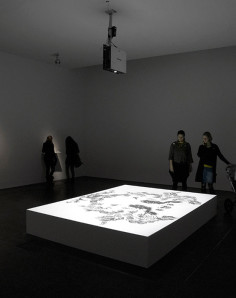Saara Ekström
Dust II

source: saaraekstrom
“Architecture has, with some difficulty, liberated itself from the ornament, but it has not liberated itself from the fear of the ornament”, stated John Summerson in 1941 as a comment of the modernistic architecture that strived towards an even stricter and purer depiction of space. The style demanded an economically efficient and simplified architecture, but paradoxically a structure stripped from all decoration turned up to be unpractical and complicated to accomplish; a tower ends inevitably in a point and the twist of a staircase is ornamentation in itself. Despite the sacrifices, the advanced architecture had to be protected against the decadence of the ornament. In the video work “Dust” the ornament is concretely made of dirt and dust, degenerating materials that have to be banned from our lives and surroundings.
What is the process that turns material into dirt? The gravy on a plate is something else then on your tie, even if its consistency is still the same. Daily we clean our apartments, producing dirt and simultaneously fighting aggressively against it. We could instead lower our weapons and include the dirt as a decoration in the interior of our homes. On closer observation dust is fascinating, its greyness seems to contain all the colours and its hazy softness is bashful and withdrawn. Touch it and the fuzzy roundness will compress and disappear.
In the video titled “Dust” iron particles and dust form a series of kaleidoscopic patterns, which change from chaos into a controlled image. The images are being repeated until they form the basic ingredient of an ornament – a reoccurring, recognizable and continuing design. The dust moves on the surfaces, forming twirls and densities in the still corners of the room. The patterns that the dust settles into could be seen as graphical charts, which register the choreographies and air currents of daily movements. These ornaments reveal our habits and indicate the routes and routines our lives have taken.
.
.
.
.
.
.
.
.
source: av-arkkif
Saara Ekström asuu ja työskentelee Turussa. Hän on opiskellut mm. Turun Piirustuskoulussa vuosina 1983–86 sekä Northern Arizona Universityssa Yhdysvalloissa vuosina 1995–96. Video-, valokuva- ja installaatioteoksissaan Ekström on kiinnostunut luonnon- ja keinotekoisista materiaaleista joilla on symbolista arvoa. Ekström on osallistunut lukuisiin valtakunnallisiin ja kansainvälisiin näyttelyihin vuodesta 1986. Hänet valittiin Ars Fennica ehdokkaaksi vuonna 2002 ja Helsingin juhlaviikkojen taiteilijaksi vuonna 2005. Hänen mittavat yksityisnäyttelynsä nähtiin Amos Andersonin taidemuseossa 2005 ja Nykytaiteen museo Kiasmassa 2011. Ekströmin teoksia löytyy monista koti- ja ulkomaisista kokoelmista. – See more at: http://www.av-arkki.fi/taiteilijat/saara-ekstrom/#sthash.PzfBiIxi.dpuf
.
.
.
.
.
.
.
source: av-arkkif
Saara Ekström lives and works in Turku, Finland. She studied at Turku Drawing School (Turku Arts Academy) in Finland during 1983–86 and at Northern Arizona University in Flagstaff, the United States during 1995–97. In her video, photography and installation works, Ekström is interested in natural and artificial materials that embody strong symbolic values. She has participated in several national and international exhibitions since 1986. She was a candidate for the Ars Fennica Award in 2002 and the artist of the year of Helsinki Festival in 2005. Ekström’s extensive solo exhibitions have been seen at Amos Anderson Art Museum in 2005 and at Contemporary Art Museum Kiasma in 2011. Her works are represented in many collections in Finland and internationally. – See more at: http://www.av-arkki.fi/en/works/domestic-nature-morte_en/#sthash.s9hdIglY.dpuf

